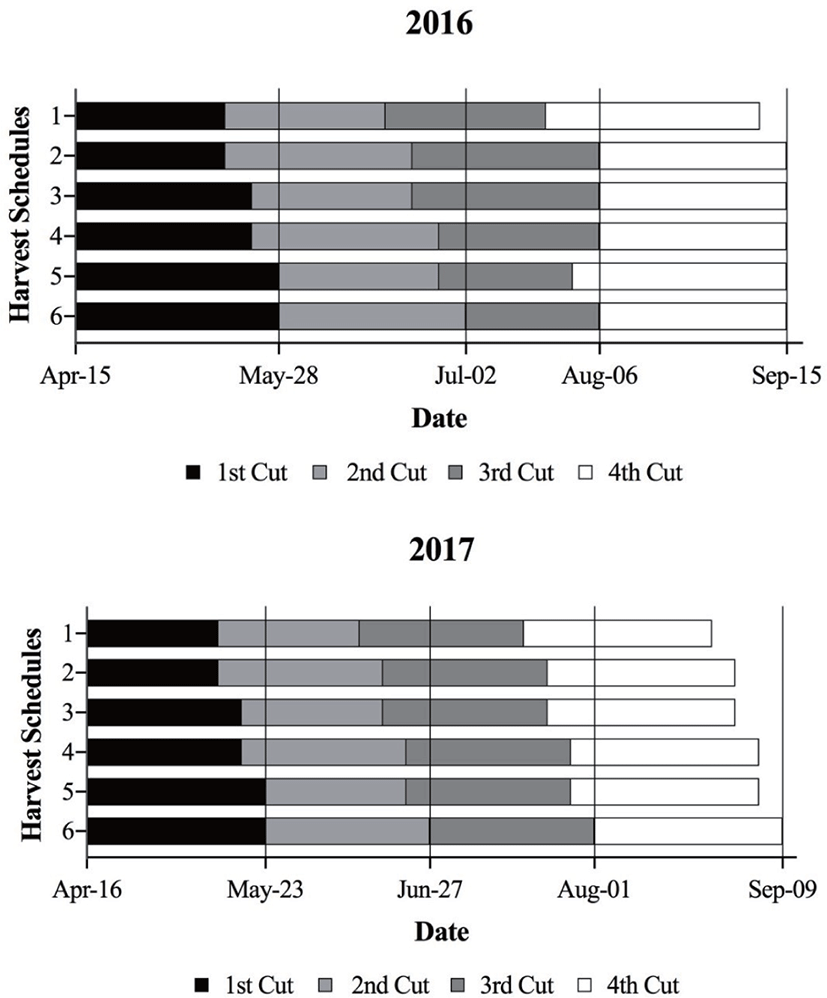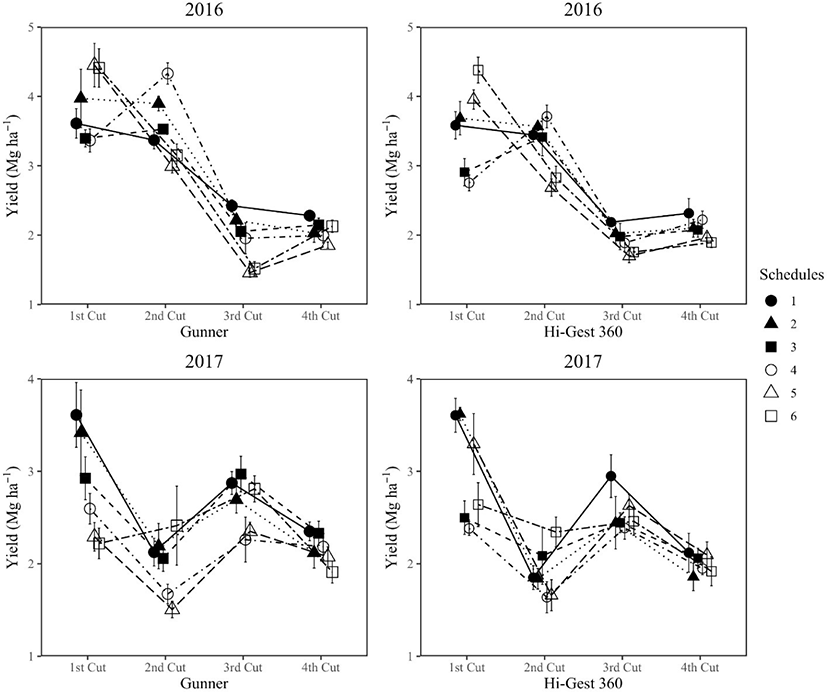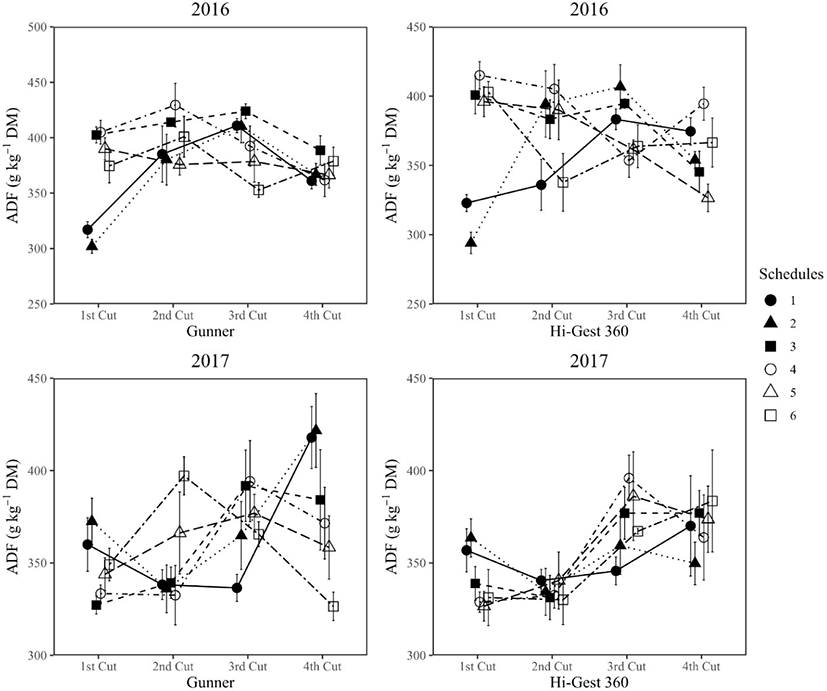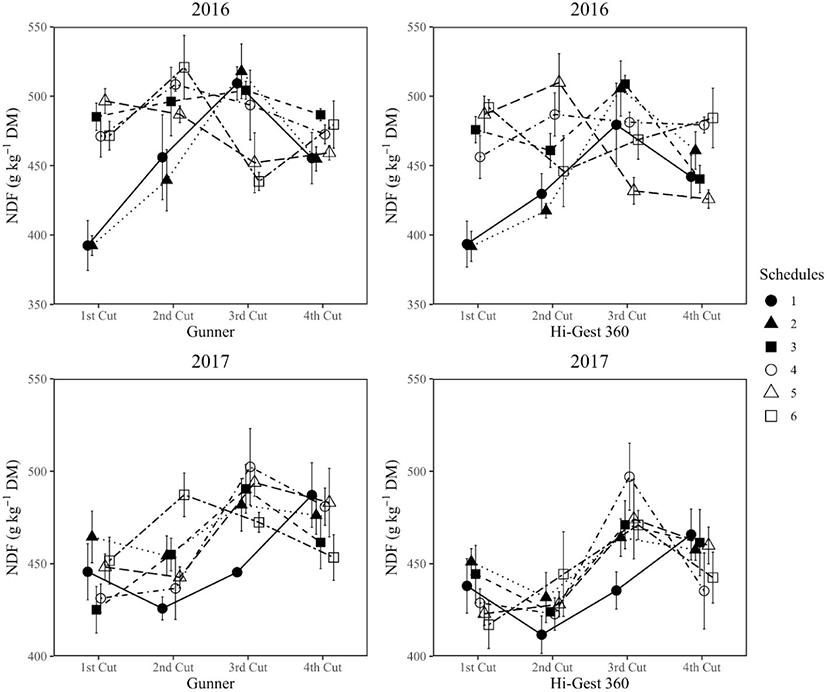INTRODUCTION
The tradeoff between yield and quality of alfalfa production could be changed by introducing low-lignin varieties. By reducing lignin content about 6 to 10%, the nutritive values of alfalfa can be expected to improve or maintain [1–4]. As a perennial legume, the performance of low-lignin varieties needs to be evaluated, specifically in the non-irrigated areas with varied weather conditions. Decreasing lignin content could bring more nutritive values for growers, however, it could alter yield, disease resistance, and morphological and physiological developments [4–7].
Previous studies have documented that shorter harvest frequency has a yield or stand persistent advantage with aggressive harvest regimes [8]. A multistate study found that reduced lignin variety maintained higher forage nutritive value compared with conventional varieties across different harvest intervals [3]. Another study reported a 20 to 30% alfalfa yield increase compared 3-cut to 4-cut in a season involving the new reduced lignin variety [6]. Two studies including reduced and low-lignin varieties also found benefits of reducing the number of cuts per season [4,9]. There are limited data on the performance of the new variety in the first and second production year, under a fixed harvest frequency. Evidence from other studies suggests that higher harvest frequency could account for yield loss, reduced stand density and crown mass [10]. Information is needed on the response of low-lignin alfalfa subject to diverse harvest schedules.
Alfalfa is required to have a fall cutting four to six weeks before the first killing frost [11]. The flexibility of adjusting cutting intervals is limited when growers fix harvest frequency because of the first killing frost. It is essential to schedule the first two harvests for one season. Several studies have documented more significant effects of different cutting intervals in spring and early summer on alfalfa yield and nutritive value, compared to late summer [8,10,12]. A previous study reported that alfalfa harvest system with the first and second cuttings occurred earlier, and the delayed third or fourth cutting were superior, which compared to alfalfa harvest system with fixed intervals [13]. For alfalfa varieties with low-lignin content, the first cutting according to plant height might follow the same time producers harvest conventional varieties [7]. We hypothesized that adjusting harvest intervals for the first two cutting would benefit forage yield and nutritive values.
Growers often take small risks with cutting schedules, however, new varieties with low lignin content and competitive yields may allow growers to adjust the time of harvest [7]. The objective of this study was to evaluate field performance and cash value of low-lignin and conventional varieties under four-cut systems, with diverse harvest schedules during the first and second production year.
MATERIALS AND METHODS
Hi-Gest 360 and Gunner were seeded on August 25, 2015, at the Department of Agronomy Ashland Bottoms Research Farm (39.13° N, 96.63° W), near Manhattan, KS, on a Rossville silt loam (very rarely flooded), non-irrigated area. The seeding rate was 20 kg ha−1. Hi-Gest 360 represents the low-lignin variety (conventional breeding technology), while Gunner represents the conventional variety.
Soil samples were taken and submitted to the Kansas State University Soil Testing Lab to check soil fertility, with soil pH 7.9, 125 mg kg−1 phosphorus, and 332 mg kg−1 potassium. Lambda-cyhalothrin was applied at 25 g ha−1 late spring and early summer in 2016 and 2017 to control alfalfa weevil. For controlling other insect pests, Zeta-cypermethrin × S-Cyano was applied at 28 g ha−1 in early May. No fertilizers were applied to the plots during the experiment. Monthly mean maximum and minimum air temperature and rainfall data were collected from 2016 to 2017 (Table 1). Weather data were download from the station at Ashland Bottoms, KS (http://mesonet.k-state.edu/weather/historical/).
Individual plots were 1.5 by 4.5 m. Plots were harvested with a Carter small plot harvester, leaving 5-cm tall stubble. No plots were harvested in the establishment year (2015). All plots were harvested four times during the first and second production year. In order to condition harvest cost and compare six intensive schedules, four cutting times were used (Fig. 1).

Fresh mass data of the harvested alfalfa was collected. A subsample from each plot was weighed fresh and dry to determine dry matter yield. Fresh samples were kept in the dryer at 60°C for 72 hours. After that, dry samples were ground in a Wiley mill to pass a 1-mm screen for nutritive value analysis. Crude protein (CP) were analyzed for three replications of samples collected in 2016 and 2017. Acid detergent fiber (ADF) and neutral detergent fiber (NDF) were determined for all samples collected in 2016 and 2017. The determination of CP were according to the Kjeldahl method [14]. ADF and NDF concentration were analyzed by Ankom Fiber Analyzer (A 2000). Relative feed value (RFV) was calculated based on the ADF and NDF [15], using following equations:
The experimental design was a randomized complete block in a split-plot arrangement. There were 12 treatments of two alfalfa varieties as whole plots and six harvest schedules as subplots. In general, the first two cuttings in 2016 and 2017 were arranged in the same way (Fig. 1). Three harvest intervals including “Standard” (high quality, HQ), “Standard+5-day” (medium quality, MQ), and “Standard+10-day” (high yield, HY) were chosen in the first cutting. “Standard” represented the first cutting taken at late bud stage or when plants reached 60 cm tall approximately; two intervals including 30-day and 35-day were selected in the second cutting; the third and fourth cuttings were set to have similar last harvesting dates in 2016, and final cuts across schedules were selected within five days of each other to allow alfalfa to have enough time to restore carbohydrates before the fall dormancy. In 2017, the third and fourth cuttings were set to 35-day and 40-day, which was aiming to see the yield potential of the four-cut system. Six harvest schedules were defined as HS-1 (HQ + HQ + MQ + HY), HS-2 (HQ + HY + MQ + HY), HS-3 (MQ + HQ + MQ + HY), HS-4 (MQ + HY + MQ + HY), HS-5 (HY + HQ + MQ + HY), and HS-6 (HY + HY + MQ + HY). Data were analyzed using the GLM procedure in SAS 9.4 (SAS Institute, Cary, NC). Means separations were performed on significant effects using Fisher’s least significant difference test (LSD). The significance level was 0.05 in this study.
RESULTS AND DISCUSSION
For alfalfa yield, nutritive values, and economic incomes, statistical analysis showed no significant interactions between variety and harvest schedule; therefore, only the main effects were reported.
Low-lignin alfalfa Hi-Gest 360 and conventional alfalfa Gunner did not show a significant difference in yield in 2016 and 2017 (Fig. 2). The low-lignin variety (10.8 Mg ha−1 and 9.5 Mg ha−1 in 2016 and 2017, respectively) tended to have a similar dry matter yield compared to the conventional variety (11.4 Mg ha−1 and 9.7 Mg ha−1 in 2016 and 2017, respectively), but no statistical difference was found (Table 2). The research comparing low-lignin and reference alfalfa varieties in Minnesota has also concluded that forage yield differences were less showed in the first production year [9].

Alfalfa yields significantly (p < 0.05) differed among six harvest schedules and the trend was relatively consistent across two years. Yield differences were greater in the second production year (2017) than the first production year (2016). In 2016, HS-1 and HS-2 provided the highest forage yields, while HS-3 and HS-5 were significantly lowest with alfalfa yield (Table 2). Extended intervals were not necessary to achieve greater yields regardless of variety. Testa et al. [16] attributed the loss of leaves to delay harvest time. Choosing 28-day or fewer days intervals for the first and second cuttings in this study resulted in avoiding unfavorable drought weather during the summer, especially in July 2017 (Table 1). The regrowth of HS-1, HS-2, and HS-3 after the second cutting obtained the marginal rainfall before the summer slump compared to the HS-4, HS-5, and HS-6.
Varieties showed no differences in CP concentration. Numerically, Hi-Gest 360 produced more protein values than Gunner did in 2016 and 2017, no statistical evidence was shown. The study conducted in California and Pennsylvania showed that varieties including Hi-Gest 360 had similar CP concentrations in the seeding year [17]. Grev et al. [9] also reported that CP concentrations of reduced lignin alfalfa (54HVX41) were not significantly different to CP concentrations of other varieties at two of three locations in both seeding year and first production year. The improved traits of new varieties showed certain degree of advantages in CP levels [4,9].
Harvest schedule treatment did not influence CP concentration (Table 2). The significant differences in harvest schedules existed in the first and the second cuttings, and the intervals of each harvesting were controlled in a realistic way to represent alfalfa production. As ten days differences between HS-1 and HS-6 in the first and second cuttings were not enough to show a significant result in CP level. These results were expected and agree with data from previous studies indicating a fluctuated trend could be observed as delaying harvesting, but results are not statistically significant [18–20].
Across two years, Hi-Gest 360 contained less NDF concentrations compared to Gunner (Table 2). Variety did not significantly differ in ADF concentration and RFV in 2016 and 2017. Sulc et al. [17] found reduced NDF concentrations for Hi-Gest 360 compared to one of the reference varieties (54R02). Other previous studies reported that NDF concentrations were less for reduced lignin alfalfa (HarvXtra) compared to reference varieties [3,4,9,21]. Given weather variation between 2016 and 2017 in this study, our results demonstrated that low-lignin alfalfa Hi-Gest 360 had higher nutritive value potential in the first and second production year than the conventional alfalfa Gunner (Table 3).
The harvest schedule effects on forage nutritive value were more pronounced in the first production year (2016) than in the second production year (2017). In 2016, harvest schedules were categorized into two major parts, HS-1 and HS-2 demonstrated a premium quality, while the other four schedules fell into the low-quality category. ADF and NDF concentrations, and RFV for all harvest schedules ranged from 361 to 395 g kg−1, 445 to 482 g kg−1, and 113 to 129, respectively. In 2017, the alfalfa responded to extreme weather differently. ADF concentration had no significant difference in 2017 and the LSD tests showed the limited effect of harvest schedules on NDF concentration. In contrast to the results in 2016, HS-2 to HS-6 maintained a higher RFV (128 to 129) compared to HS-3 (122). The inconsistency of nutritive value between 2016 and 2017 was likely due to the drought in June and July 2017 (Table 1). Drought might have delayed the maturity resulting in a higher quality forage [22].
Under the normal weather condition, especially during the growing season, the results of nutritive values were expected. Alfalfa is more likely to develop its morphological characteristics according to different schedules. The design of bringing forward the first two cuttings which happen in late spring and early summer would provide forage with high nutritive value when the precipitation is not extremely limited. Similarly, Brink et al. 3/3/2022 5:26:00 PM[12] emphasized the critical impact of the spring and early summer harvest on nutritive values in humid regions. In Figs. 3 and 4, six harvest schedules showed similar trends in 2017 and more effect of shorter intervals were more pronounced in 2016.


Yield and nutritive value were analyzed again after removing data of the third and fourth cuttings each year since the first and second harvesting represent more than two third of the total yield (Fig. 2). Moreover, the major differences in the harvest intervals were assigned to the first and second cuttings for both years.
In 2016, alfalfa dry matter yield of the first two cuttings were 65% and 63% of annual yield for Hi-Gest 360 and Gunner, respectively. In 2017, alfalfa yield of the first two cuttings was 50.5% of annual yield for both varieties. Hi-Gest 360 showed a slightly lower yield in the first production year (Table 3). In 2017, the rainfall of May and June was 168.4 mm less than the rainfall of May in 2016. The second cutting of each harvest schedules was affected by limited rainfall (Fig. 2).
HS-2 targeting on getting HQ and HY behaved the greatest compared with other schedules in the first and second production year. Yield results were variable due to different weather conditions in two years. Extending intervals in the first and second cuttings was not a valuable management practice for more yields, which suggests that harvesting alfalfa could rely on the morphological development other than rigidly according to a fixed number of intervals [23]. In the first production year, there were no differences between HS-4 and HS-1 in forage yield. HS-3 and HS-4 produced the least forage yield when combining data in two years. Harvest schedule subjected to fixed lengths or conservative patterns were unlikely to overcome the effect of extreme weather conditions.
Across the years, Hi-Gest 360 maintained lower NDF concentrations than Gunner (Table 3). ADF concentrations and RFV of Hi-Gest 360 (338 g kg−1, 136) demonstrated greater nutritive values compared to Gunner (350 g kg−1, 128) in 2017. Sulc et al. [17] reported that Hi-Gest 360 was significantly different in nutritive value when compared with one of the reference varieties (54R02).
Nutritive values (ADF, NDF concentrations and RFV) differed among six harvest schedules regarding the first and second cuttings in 2016 and 2017. Across two years, HS-1 showed a good adaption to different weather pattern producing HQ alfalfa product. Bringing forward harvest dates in early growing season increased forage nutritive value and studies investigating the harvest intervals have also found similar reduced NDF concentrations for shorter intervals or more frequent harvest systems [3,8,9,12,16,17]. However, in 2017, ADF concentrations were less for HS-4 (332 g kg−1) compared to HS-6 (352 g kg−1), and NDF concentrations were less for HS-1 (430 g kg−1) and HS-4 (430 g kg−1) compared to HS-6 (450 g kg−1). Extreme weather conditions such as drought could alter the effects of different harvest schedules on forage nutritive value. Growers would adjust their harvest strategies integrating both morphological traits and environmental factors.
According to the Kansas Direct Hay Report, alfalfa hay value was at approximately $1.00 per point RFV (https://www.ams.usda.gov/mnreports/ams_2885.pdf). For a better comparison, alfalfa price in this study was set at $1.00 per point RFV. Economic incomes ($ ha−1) were equal to RFV multiplied by the yield from each cutting.
Two alfalfa varieties in this study were tolerant of a diversity of harvest schedules and had no difference in economic incomes throughout the first and second production year. Hi-Gest 360 showed slightly more value than Gunner when combining economic incomes in both years (Table 4).
HS-1 and HS-2 demonstrated a consistent higher value per hectare than other schedules in 2016 and combining data in two years, which suggests that if growers only adjust the first two cuttings, shorter intervals with 28-day for the first cutting and 30-day for the second cutting benefit their incomes regarding forage quality in the early cuttings and longer intervals bring more production in the later cuttings (Table 4). The increased production would make up the loss of nutritive value in the third and fourth cuttings. The declining speed of nutritive value in the late season was slower compared to the early season. However, the delaying harvest system needs to be reconsidered when alfalfa suffers drought and extremely hot summer.
CONCLUSION
Forage yield differences among harvest schedule were more pronounced than yield differences between two varieties. Harvest schedules prone to higher nutritive values tend to maintain a similar forage yield compared to harvest schedules with longer intervals. The nutritive value data suggest two things. First, harvest interval has a significant effect on nutritive value of alfalfa and a more substantial effect than cultivar selection. Second, the nutritive value of low-lignin alfalfa variety was significantly greater than conventional variety, offering producers the flexibility to adjust the harvesting schedule confronting unpredictable weather. The concept of comparing the economic incomes of different varieties and harvest schedule provides an alternative way of reviewing forage management practices more reasonably and comprehensively. HS-1 had highest economic incomes when considering RFV and yield among the six different harvest schedules. It appears that the low-lignin alfalfa variety also has the potential to increase producers’ incomes compared to the conventional variety.
















